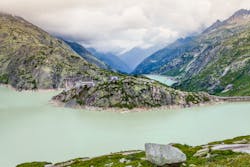Case study: Reducing wear on hydraulic control valves in a hydroelectric power plant
The Kraftwerke Oberhasli AG (KWO) power plant can generate energy on demand at any time using water dammed in Lake Grimsel, 1,909 meters above sea level. The Swiss energy company generates electricity and stabilizes the grid in Switzerland and Europe from its hydroelectric power plants in the Grimsel area. Reservoirs act as natural batteries in which energy can be stored in the form of water and used later to generate electricity.
However, the use of natural glacial runoff and rain water poses a problem — suspended matter. The glacier is continuously eroding fine stone particles from the mountains. These solids, derived from glacial abrasion, are transported by the runoff into the reservoir and collect with other suspended matter brought in by rainfall. These 25- to 200-micron (µm) particles pose a problem for the huge turbines in the KWO power plants, and they cause heavy wear of the slide valves. These valves use the pressure of the water to control the ball valves, which in turn control the intake to the turbines. Due to the water’s drop height of 670 meters, high pressures occur in the valves and their supply lines.
Hydraulic control valve wear
Sand settling tanks in place upstream prevent the entry of coarse particles into the control valves, however they have demonstrated only limited success.
“Until now, the valves had to be cleaned and repaired by the KWO every three to four months,” said Franz Christen, sales and technical manager at BT-Hydraulik AG, which was commissioned by KWO to find a solution to the problem.
In the past, the valves even had to be completely replaced on a regular basis, but now they are no longer available on the market. To reduce, or ideally, eliminate costly and time-consuming repairs, the hydroelectric power plant operator was interested in finding a new solution.
“The installation of larger settling tanks was not an option,” said Christen. “At water pressures of 870 to 1,450 psi or even more, large and complex tanks would be needed. But that would not be feasible for economic and environmental reasons, and for lack of space. Converting to oil hydraulics was likewise not feasible for the same reasons.”
KWO decided to install filter systems directly upstream of the control valves and turned to BT-Hydraulik, a company in the field of hydraulic drive technology. The Berne-based company advised KWO to use an automatic basket strainer.
“Conventional filters clog up over time and need to be serviced and replaced at regular intervals,” Christen said. “An automatically self-cleaning filter is the more economical solution.”
The problem was that standard backwash filters are not designed for the high pressures in a hydroelectric power plant. BT-Hydraulik, together with Eaton, refined the Eaton Model 2596 strainer. This motor-driven strainer provides continuous removal of solids from fluids in pipework systems — though only within a standard pressure range up to a maximum of 232 psi. Eaton provided customization of this filter system to serve customer-specific applications.
Solution
A version of the Eaton Model 2596 automatic basket strainer was developed for KWO for pressures of up to 1,160 psi. To withstand the high pressures, Eaton modified the entire housing by increasing the wall thickness and making the cover sturdier. In addition, the flushing arm drive shaft was sealed with a quadruple mechanical seal.
“A particularly challenging problem was to find a filter element that offered the highest possible filter fineness that could also withstand the high pressures and was backwashable,” said Christen.
A reinforced version of the DuraWedge filter element proved the solution. Made of V-shaped stainless steel wire profiles, even the standard version is capable of being used in demanding applications. After being further reinforced, the plant now can withstand the high pressures, filtering out a large part of the suspended matter due to a filter fineness of 25 µm.
“The system had to be additionally adjusted so that the screen baskets would not be deformed in the backwash phase,” said Christen. “A pressure reduction of 870 psi to the ambient pressure would have been problematic despite the reinforcement.”
The four high-pressure basket strainers used in KWO’s hydroelectric power plant have also been adapted to the operating parameters used there. The connector size for two of the filters is two inches and for the other two is three inches, with a flow rate of between 53 and 106 gallons per minute (gpm). However, the design of the high-pressure strainer basket developed jointly by Eaton and BT-Hydraulik can also be adapted to other parameters — in line with whatever the application requires. The backwash is triggered by an Eaton control — in KWO’s case, whenever the differential pressure reaches 11.6 psi. Alternatively, control using predetermined time intervals or permanent backwashing would also be feasible.
Conclusion
Even though the test phase of the new filter system at KWO is scheduled to run for several years, initial results are already clear. So far the plant has had no outages and the system meets its needs in terms of maintaining and cleaning the baskets. Compared to the turbine lines where the sliding gate valves have not yet been retrofitted, wear and tear has been reduced. The amount of maintenance required and the associated costs have been minimized by the high-pressure automatic basket strainer.




